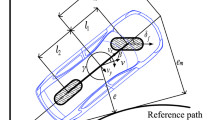Abstract
Unmanned vehicles have drawn wide attention due to their intrinsic capacity of performing routine tasks for industry, conducting military missions and improving traffic safety. However, since the longitudinal dynamic system of unmanned vehicles inherently has the uncertain nonlinearities and time-varying behavior, longitudinal tracking control is reviewed as a challenging work in the exploitation of unmanned vehicles to deal with the features of uncertain nonlinearities and parametric time varying. In this paper, an adaptive nonlinear cascade control architecture is presented to design the longitudinal speed tracking control for unmanned vehicle, which is a nonholonomic system. Firstly, a upper-level model predictive control law is presented to produce a desired and smooth acceleration in real time, and the saturation characteristic is introduced to limit the accelerations within the range of given values. Then, a lower-level adaptive neuro-network sliding mode control (ANN-SMC) law is presented for dynamically tracking the desired acceleration, in which the uncertain term and the variable structure control term are adaptively adjusted by the neuro-networks, and the stability of proposed ANN-SMC control system is proved by the Lyapunov theory. Finally, simulation and experimental results demonstrate the feasibility and effectiveness of proposed control approach.









Similar content being viewed by others
References
Toulotte, P., Delprat, S., Guerra, T., Boonaert, J.: Vehicle spacing control using robust fuzzy control with pole placement in LMI region. Eng. Appl. Artif. Intel. 21(5), 756–768 (2008)
Peng, Y.F.: Adaptive intelligent backstepping longitudinal control of vehicle platoons using output recurrent cerebellar model articulation controller. Expert Syst. Appl. 37(3), 2016–2027 (2010)
Wang, J., Zhang, L., Zhang, D., Li, K.: An adaptive longitudinal driving assistance system based on driver characteristics. IEEE Trans. Intell. Transp. Syst. 14(1), 1–12 (2013)
Hakgo, K., Dongwook, K., Insoo, S., Yi, K.: Time-varying parameter adaptive vehicle speed control. IEEE Trans. Veh. Technol. 61(2), 581–588 (2016)
Li, S., Li, K., Rajamani, R.: Model predictive multi-objective vehicle adaptive cruise control. IEEE Trans. Control Syst. Technol. 19(3), 556–566 (2011)
Thomas, S., Luigi, R.: A model predictive cooperative cruise control approach. In: American control conference, Washington, USA, June 17–19 (2013)
Hu, P., Guo, J., Li, L., Wang, R.: A robust longitudinal sliding-mode controller design for autonomous ground vehicle based on fuzzy logic. Int. J. Veh. Auton. Syst. 11(4), 368–383 (2013)
Gerdes, J., Hedrick, J.: Vehicle speed and spacing control via coordinated throttle and brake action. Control Eng. Pract. 5(11), 1607–1614 (1997)
Nouveliere, L., Mammar, S.: Experimental vehicle longitudinal control using a second order sliding mode technique. Control Eng. Pract. 15(8), 934–954 (2007)
Ferrara, A., Vecchio, C.: Second order sliding mode control of vehicles with distributed collision avoidance capabilities. Mechatronics 19(4), 471–477 (2009)
Liang, H., Chong, K.T.: Vehicle longitudinal brake control using variable parameter sliding control. Control Eng. Pract. 11(4), 403–411 (2003)
Hongyi, L., Jinyong, Y., Chris, H., Honghai, L.: Adaptive sliding-mode control for nonlinear active suspension vehicle systems using T-S fuzzy approach. IEEE Trans. Ind. Eletron. 60(8), 3328–3338 (2013)
Hongyi, L., Peng, S., Deyin, Y., Ligang, W.: Observer-based adaptive sliding mode control for nonlinear Markovian jump systems. Automatica 64(2), 133–142 (2016)
Yang, Y., Wu, J., Zheng, W.: Station-keeping attitude control for an autonomous airship using feedback linearization and sliding mode control. Int. J. Innov. Comput. Inf. Control 8(9), 152–165 (2012)
Nasirin, A., Nguang, S.K., Swain, A.: Adaptive sliding mode control for a class of MIMO nonlinear systems with uncertainties. J. Frankl. Inst. 351(4), 2048–2061 (2014)
Bong, S., Sung, J., Jin, B., Yoon, H.: Adaptive neural sliding mode control of nonholomic wheeled mobile robots with model uncertainty. IEEE Trans. Control Syst. Technol. 17(1), 207–214 (2009)
Peric, S.L., Antic, D.S., Milovanovic, M.B., Mitic, D.B.: Quasi-sliding mode control with orthogonal endocrine neural network-based estimator applied in anti-lock braking system. IEEE/ASME Trans. Mechatron. 21(2), 754–764 (2016)
Rajamani, R.: Vehicle dynamics and control. Springer, Berlin (2012)
Jullierme, E., Alves, D.: Longitudinal model identification and velocity control of an autonomous car. IEEE Trans. Intell. Transp. Syst. 16(2), 777–786 (2015)
Dai, L., Xia, Y., Gao, Y., et al.: Cooperative distributed stochastic MPC for systems with state estimation and coupled probabilistic constraints. Automatica 61(11), 89–96 (2016)
Siavash, K., Mosttafa, J., Hossein, A.: Adaptive fuzzy SMC based formation design for swarm of unknown time-delayed robots. Nonlinear Dyn. 69(4), 1825–1835 (2012)
Nasirin, A., Nguang, S.K., Swain, A.: Adaptive sliding mode control for a class of MIMO nonlinear systems with uncertainties. J. Frankl. Inst. 351(4), 2048–2061 (2014)
Yang, Y., Yan, Y., Zhu, Z., Zheng, W.: Positioning control for an unmanned airship using sliding mode control based on fuzzy approximation. Proc. Inst. Mech. Eng. G J Aerosp. 228(12), 2627–2640 (2014)
Yang, Y., Wu, J., Zheng, W.: Trajectory tracking for an autonomous airship using fuzzy adaptive sliding mode control. J. Zhejiang Univ. Sci. C. 13(7), 534–543 (2012)
Mohammadzadeh, A., Ghaemi, S.: A modified sliding mode approach for synchronization of fractional-order chaotic/hyperchaotic systems by using new self-structuring hierarchical type-2 fuzzy neural network. Neurocomputing 191(5), 200–213 (2016)
Ge, S., Hang, C., Lee, T.: Stable Adaptive Neural Network Control. Springer, Berlin (2002)
Kosari, A., Maghsoudi, H., Lavaei, A., Ahmadi, R.: Optimal online trajectory generation for a flying robot for terrain following purposes using neural network. Proc. Inst. Mech. Eng. G J Aerosp. 229(6), 1124–1141 (2015)
Li, S., Jiang, X.Q.: RBF neural network based second-order sliding mode guidance for Mars entry under uncertainties. Aerosp. Sci. Technol. 43, 226–235 (2015)
Yan, Ye: Neural network approximation-based nonsingular terminal sliding mode control for trajectory tracking of robotic airships. Aerosp. Sci. Technol. 54, 192–197 (2016)
Acknowledgements
This work was funded by the National Natural Science Foundation of China (No.61304193, No.U1564208), National Basic Research Project of China (No. 2016YFB0100900). Authors are grateful for helpful comments from referees to improve this manuscript.
Author information
Authors and Affiliations
Corresponding author
Rights and permissions
About this article
Cite this article
Guo, J., Luo, Y. & Li, K. Adaptive neural-network sliding mode cascade architecture of longitudinal tracking control for unmanned vehicles. Nonlinear Dyn 87, 2497–2510 (2017). https://doi.org/10.1007/s11071-016-3206-2
Received:
Accepted:
Published:
Issue Date:
DOI: https://doi.org/10.1007/s11071-016-3206-2




